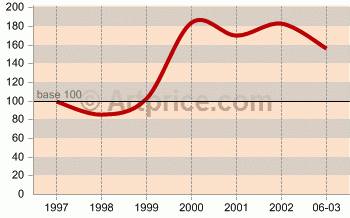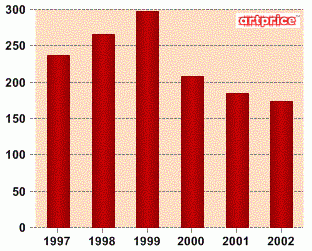Alexander Calder (1898-1976)
[04 Dec 2003]
Christie’s has just set a new record for a sculpture by Alexander Calder. However, it is his works on paper that are the main focus of the price surge.
Alexander Calder was born into a family of artists in 1898. However, he first pursued a career as an engineer, something which was to help him later on. He was already 25 years old before he finally decided to join New York’s Art Students’ League. He started out as a comic illustrator. A magazine commission led him into the circus world, lighting a passion which inspired him to create his own miniature circus with articulated performers and animals. This installation is now an exhibit at New York’s Whitney Museum. In 1928 the Weyhe Gallery staged his first solo exhibition, featuring human caricatures. He soon became friendly with Joan Miro, Fernand Léger and Marcel Duchamp. His 1930 meeting with Piet Mondrian was to be a turning point, and he set about producing completely abstract works, creating his first motorised kinetic sculptures in 1931. These were dubbed “mobiles” by Marcel Duchamp, while his later mobiles would be driven by wind, prompting Jean Harp to call them “stabiles”. The mid-1930s saw his first large sculptures for outdoors exhibition and orders for his work increased. During the Second World War he started sculpting in wood, creating the “constellations” series. The MoMA organised a retrospective of his work in early 1943. In the 1950s and 1960s, he produced a large number of lithographs, tapestries, engravings and paintings, many of these in gouache. Calder devoted more time to producing monumental sculpture commissions in his later years.
Artworks at auctions
Alexander CALDER was one of the most prolific sculptors. His catalogue raisonné features more than 17,000 works. But aside from these, the market also offers a very large number of drawings and engravings and his sculptures account for only 17% of lots sold. There are large numbers of preparatory sketches. Around 50 of his drawings/water colours are sold each year at auction, and collectors will have to pay EUR 10,000 – 15,000 for a good example. Some of them are abstract, while others feature circus performers. The most expensive items are his large, 1-metre watercolours, which have no trouble fetching EUR 20,000 – 30,000. Nearly a hundred lithographic prints are sold each year, most of them produced in large editions, so more than half fetch less than EUR 500. His mobiles, however, are far more costly, and collectors can expect to pay in excess of USD 100,000 for a small work. And although his larger sculptures are not mobiles, they can go for more than USD 1 million – as with the monumental red sculpture made in 1968, almost 5 metres high, which set a record of USD 5.2 million on 11 November 2003 at Christie’s.
The market places
The market for Alexander Calder is thoroughly international. Although US auction houses sell half of his work, collectors can find a large number of gouaches and lithographs in France. These are often published by the Fondation Maegth, with whom the artist collaborated for more than 25 years. He also used to pay regular visits to a pied-à-terre in France in the 1960s. Enthusiasts will also find very large numbers of his work on paper in Germany and Switzerland, and will sometimes come across his sculptures in London.
Buy or sell
Alexander Calder’s prices exploded in 1999 following his major retrospective in 1998, rising 79% in one year. His price has held firm since, thanks to the dearth of supply and sustained demand (only 14% of lots were unsold in 2002). The price of his sculptures has recently started to weaken. Aside from his exceptional works, current prices for mobiles are generally on a par with 1997. The price of his gouaches and lithographic prints, however, has been rising strongly since January 2003. Aside from these traditional media, his tapestries are particularly sought after at the moment. Most sold lots have beaten even the most optimistic estimates. Serpent Presse, for example, an Aubusson tapestry measuring 2.69 metres by 1.8 metres, sold for USD 11,000 on 24 September 2003 at Christie’s, against its estimate of USD 3,000 – 5,000.
Alexander CALDERArtprice Indexall media categories, base January 1997 = 100  Alexander CALDERLots sold at auctions
Alexander CALDERLots sold at auctions  Alexander CALDERAuction sales turnover 1999-2002 / weight by country
Alexander CALDERAuction sales turnover 1999-2002 / weight by country  © Artprice
© Artprice




 0
0
